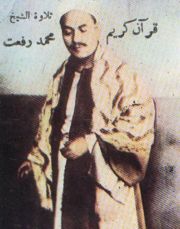Difference between revisions of "Qur'anic recitation (tilawa)"
| Line 17: | Line 17: | ||
study and private devotions. Recently it has become more popular for listening, probably due to Egyptian | study and private devotions. Recently it has become more popular for listening, probably due to Egyptian | ||
worker migration to Saudi Arabia, as well as increasing religious conservatism; the conservatives critics | worker migration to Saudi Arabia, as well as increasing religious conservatism; the conservatives critics | ||
| − | often condemn the older mujawwad style as “singing” the Qur’an. From a commercial recording. | + | often condemn the older mujawwad style as “singing” the Qur’an. From a commercial recording. [http://www.youtube.com/watch?v=qUbGImJikuo Video: Surat Qiyama] |
* [http://www.youtube.com/watch?v=riW4W66ptqI Quranic recitation: Surat al-Rahman (video)] | * [http://www.youtube.com/watch?v=riW4W66ptqI Quranic recitation: Surat al-Rahman (video)] | ||
Revision as of 11:12, 27 September 2007
- Qur’anic recitation (mujawwad). Performed by Shaykh Muhammad Rif‘at ((May 9, 1882 - May 9, 1950), the earliest great reciter to be
recorded in Egypt, during the early part of this century. This is again the mujawwad style; note the pauses, repeats, slow delivery, melisma, melodic inventiveness. This style allows the performer to create maximal emotional power.
- Qur’anic recitation (mujawwad). Performed by Shaykh ‘Abd al-Basit ‘Abd al-Samad. A great Egyptian
reciter who passed away relatively recently (1927-1988). Note how each reciter has his style. This too is the
mujawwad style.- Qur’anic recitation (murattal). Performed by Shaykh Ahmad al-‘Ajami, from Saudi Arabia. Note the
contrast with the previous two examples: here, recitation is rapid, narrower in melodic scope, little melisma, always moving forward without pauses. This style, called murattal, was traditionally used for study and private devotions. Recently it has become more popular for listening, probably due to Egyptian worker migration to Saudi Arabia, as well as increasing religious conservatism; the conservatives critics often condemn the older mujawwad style as “singing” the Qur’an. From a commercial recording. Video: Surat Qiyama

